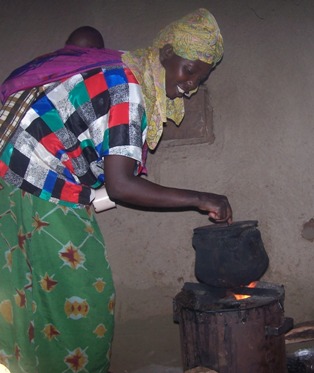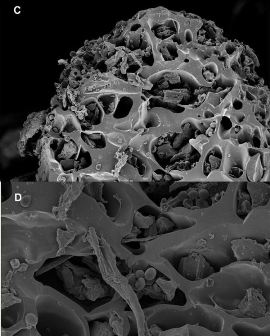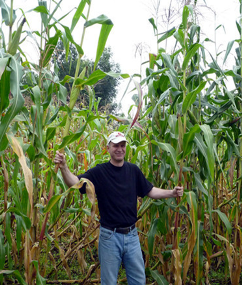|
Home |
Updates |
Our Team |
Media |
References |
Documents
|
Updates on Our Research
Updated July 2011
|
| Clean-burning pyrolysis cookstoves: design and modeling |

Above: Slice through the annular version of the cookstove design used for modeling purposes, with an inner cylinder (radius R1) and outer annulus (width W). A (the air gap to the pot) and L (the top shoulder wall) are two modeling parameters used in the response surface graph below.

Above: velocity and temperature fields for a slice through half of the annular cookstove, with pyrolysis chamber in the middle and combustion zones to the left and right (see schematic above). On the velocity field at left, the jet emerging from the top of the combustion chamber towards the pot is seen. At right, a temperature profile shows the high temperatures of combusting gases near the outlet at the bottom of the pyrolysis chamber. |
Guided by existing stove designs and our modeling work to date, We are now using ANSYS/FLUENT software to optimize models for char-producing stoves of two basic geometries: (1) annular, and (2) top-lit updraft (TLUD). Here we focus on the annular design shown at left. In this design the central cylindrical pyrolysis chamber is heated by the combustion products from a conventional biomass fire below and outside it, and contributes gas-phase fuel to the combustion zone.
|

Above: Surface of response for a stove evaluation metric, CO produced per KJ power output, to the stove-pot gap A (right axis) and the top wall length L (front axis, see schematic at top). Lower values denote better stove performance. |
High energy output and low emissions are two important criteria for the stove, and we are using the ratio of carbon monoxide (CO) per unit power output of the stove as an important initial metric when evaluating model outputs as guidance for building test stoves. At left we show model outputs for how this ratio depends on the stove-pot gap A and the top wall length L shown in the schematic above. An ideal stove would have low CO emissions with a high power output, and an excellent conversion efficiency of the pyrolyzed fraction of biomass fuel into energy.
|

Above: Time course of production of gas and tar combustible components during a short model run for biomass in the central pyrolysis chamber. |
Meanwhile, we are also modeling the pyrolysis of biomass in the central pyrolysis chamber using CFX modeling software. At left we show one modeled time course of gas and tar production from pyrolyzing biomass in central cylinder of the stove. The graphed production is consistent with field observations of a relatively steady rate of combustibles production during the main period of pyrolysis after startup. |
| Emissions testing and health impacts of pyrolysis cookstoves |

Photo: Farmer Mary Lagat cooks with a pilot version of the pyrolysis cookstove during field testing by Dori Torres in Kenya. (photo: D. Torres) |
Once the next generation cookstove has been developed, Rufus Edwards and Dori Torres will conduct a study on greenhouse gas emissions and indoor air pollution impacts in rural households in western Kenya. The study will monitor the improvements in emissions and indoor air pollution in households with the next generation cookstove compared to traditional stoves. Total cooking time, and amount and type of fuel used will also be monitored to assess the overall impact of stove adoption on human health and biomass stocks. |
| Biochar as a microbial inoculant carrier |

above: Microbes and fungal hyphae on biochar, visualized with a scanning electron microscope.
(photo: H. Jin)

above: petri plate test for evaluating the growth of rhizobia in a biochar or peat medium. Each dot or bacterial colony originated from one bacterium or colony-forming unit within the microbial carrier. (photo: S. Vanek) |
The Thies lab has begun a series of trials to test biochar as an inoculant carrier. We will work with rhizobium and bradyrhizobium bacteria that carry out nitrogen fixation in symbiosis with legumes, and which are among the most important organisms currently distributed as inoculants. The trial will identify chemical and physical properties of the biochar that explain its performance as a carrier. Flourescence microscopy and other techniques will also be used to visualize the bacteria on the biochar and look for location of bacteria on the char surfaces and mechanisms of attachment and survival. We are also preparing to expand the inoculant trial work to other organisms such as mycorrhizae or beneficial Pseudomonas species. |
| Biomass assessment to examine fuel use and fuel sources |

Photo: fuelwood gathering near Kisumu, Kenya. (photo: D. Torres) |
While also assisting the stove development team with design work on the stoves, Dori Torres is currently in Kenya with World Agroforestry Center (ICRAF) staff, conducting a pilot phase and testing methodologies for a large scale biomass assessment to inform modeling efforts by the project team. She is using a combination of quickbird satellite imagery and ground-truthing assessments of individual plots. We look forward to her initial results. |
Biochar and inoculant impacts in nutrient cycling in soils |
 Above: Johannes Lehmann shows a biochar plus fertilizer plot at left compared to a plot with a green manure plus fertilizer. (photo: J. Berazneva) |
The Lehmann lab is researching the impacts of biochar inoculants on crop growth and how biochar applied to the soil can improve nutrient cycling in agroecosystems. Dori Torres is examining the molecular forms and fates of nitrogen (N) in biochar using x-ray spectroscopic analyses and a greenhouse study, to test the availability of biochar N ("black nitrogen") on N cycling. David Guerena has been researching how biochar applied to soil improves the efficiency of nitrogen fertilizer use by farmers. This research focuses on a set of sites that were converted to agriculture at different points in the past. He is also preparing to test watershed-scale impacts of biochar on stream and leaching losses of nutrients. David will also conduct a greenhouse study in Kenya to investigate the impact of different components within biochar (retained ash minerals, volatile compounds left from pyrolysis, carbon backbone structure) on nodulation and growth of beans. |

Above: Mycorrhizal hyphae (Glomus clarum) growing on biochar in a sample taken from a greenhouse experiment. (photo: S. Vanek) |
Steve Vanek has finished a first greenhouse experiment testing biochar and mycorrhizal impacts on phosphorus availability to beans. He is currently analyzing the results of the trial, and has found an interesting combination of impacts from biochar and mycorrhizae on the availability of iron phosphate, which is usually considered unavailable to crops such as beans.
Meanwhile, at ICRAF, Henry Neufeldt and Bernard Fungo are planning for a study that will test how biochar in soils can affect greenhouse gas emissions. The field sites from the other studies and the focus on nitrogen and microbes will provide a great degree of complementarity between the ICRAF and Cornell research work. |












